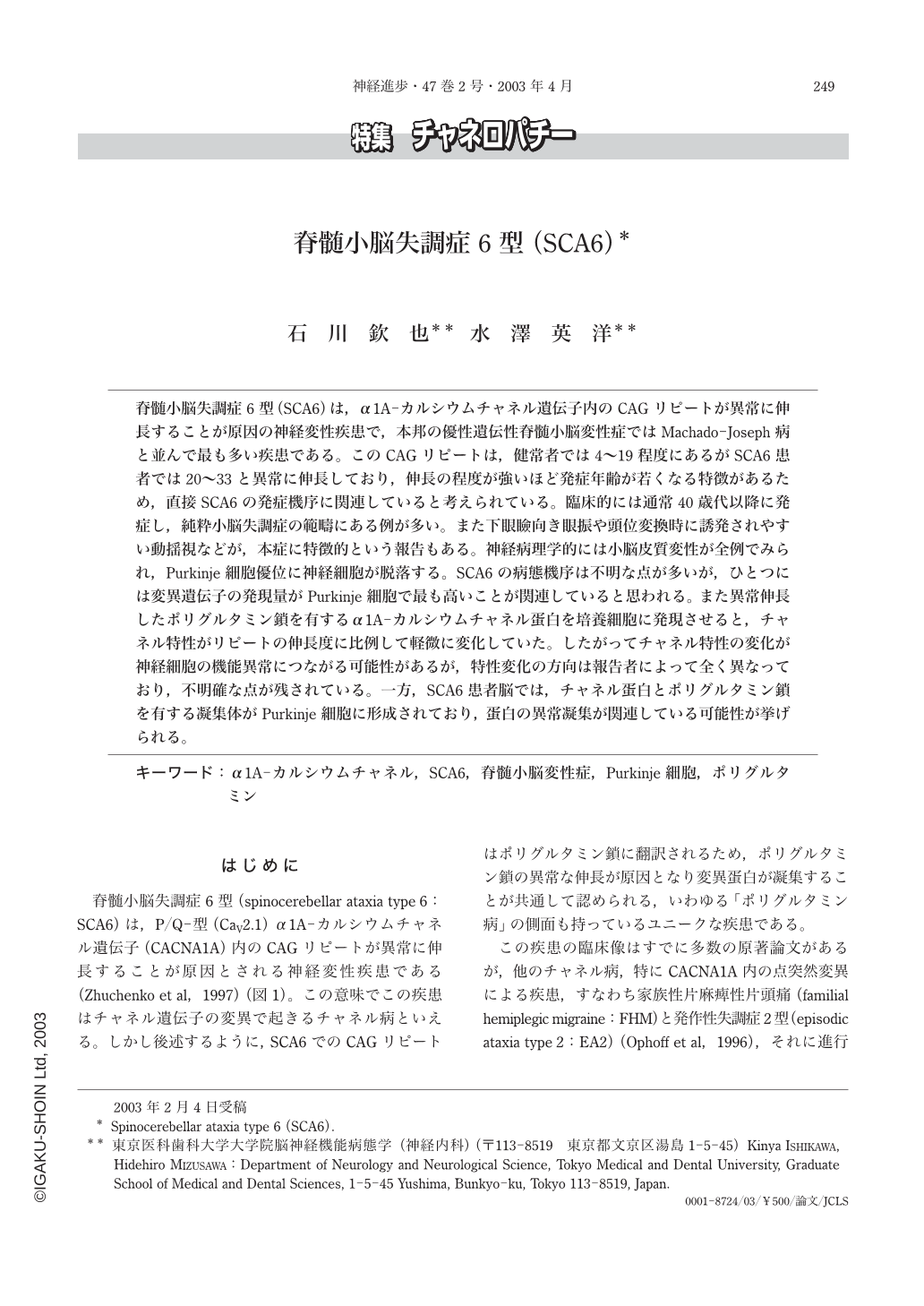Japanese
English
- 有料閲覧
- Abstract 文献概要
- 1ページ目 Look Inside
脊髄小脳失調症6型(SCA6)は,α1A-カルシウムチャネル遺伝子内のCAGリピートが異常に伸長することが原因の神経変性疾患で,本邦の優性遺伝性脊髄小脳変性症ではMachado-Joseph病と並んで最も多い疾患である。このCAGリピートは,健常者では4~19程度にあるがSCA6患者では20~33と異常に伸長しており,伸長の程度が強いほど発症年齢が若くなる特徴があるため,直接SCA6の発症機序に関連していると考えられている。臨床的には通常40歳代以降に発症し,純粋小脳失調症の範疇にある例が多い。また下眼瞼向き眼振や頭位変換時に誘発されやすい動揺視などが,本症に特徴的という報告もある。神経病理学的には小脳皮質変性が全例でみられ,Purkinje細胞優位に神経細胞が脱落する。SCA6の病態機序は不明な点が多いが,ひとつには変異遺伝子の発現量がPurkinje細胞で最も高いことが関連していると思われる。また異常伸長したポリグルタミン鎖を有するα1A-カルシウムチャネル蛋白を培養細胞に発現させると,チャネル特性がリピートの伸長度に比例して軽微に変化していた。したがってチャネル特性の変化が神経細胞の機能異常につながる可能性があるが,特性変化の方向は報告者によって全く異なっており,不明確な点が残されている。一方,SCA6患者脳では,チャネル蛋白とポリグルタミン鎖を有する凝集体がPurkinje細胞に形成されており,蛋白の異常凝集が関連している可能性が挙げられる。
はじめに
脊髄小脳失調症6型(spinocerebellar ataxia type 6:SCA6)は,P/Q-型(CaV2.1)α1A-カルシウムチャネル遺伝子(CACNA1A)内のCAGリピートが異常に伸長することが原因とされる神経変性疾患である(Zhuchenko et al,1997)(図1)。この意味でこの疾患はチャネル遺伝子の変異で起きるチャネル病といえる。しかし後述するように,SCA6でのCAGリピートはポリグルタミン鎖に翻訳されるため,ポリグルタミン鎖の異常な伸長が原因となり変異蛋白が凝集することが共通して認められる,いわゆる「ポリグルタミン病」の側面も持っているユニークな疾患である。
この疾患の臨床像はすでに多数の原著論文があるが,他のチャネル病,特にCACNA1A内の点突然変異による疾患,すなわち家族性片麻痺性片頭痛(familial hemiplegic migraine:FHM)と発作性失調症2型(episodic ataxia type 2:EA2)(Ophoff et al,1996),それに進行性小脳失調症(Yue et al, 1997)との,臨床的にみられる相違点などにも触れ,また筆者らが集積したSCA6症例での臨床的特徴点を記載してみる。またチャネル遺伝子内のCAGリピートの異常伸長がどのように疾患を起こすのか,現在解明されている知見をまとめてみる。
Spinocerebellar ataxia type 6(SCA6)is an autosomal dominant cerebellar ataxia caused by a small expansion of CAG repeat that encode polyglutamine in the alpha1A-voltage-dependent calcium channel gene. This disease is one of the most common dominantly-inherited ataxia in Japan. The CAG repeat ranges from 4 to 19 repeat-unit in normal Japanese population while the repeat is expanded in the range between 20 to 33 repeat-unit in patients. Cardinal clinical features are summarized as purely cerebellar ataxia in most SCA6 patients, although a variety of extracerebellar signs such as pyramidal tract signs or neuropathy, may be seen in some patients. Vertical gaze-nystagmus and oscillopsia are reported characteristic to SCA6. Neuropathologically, cerebellar cortical degeneration with predominant neuronal loss of the Purkinje cells is seen.
Precise mechanism that leads to neurodegeneration in SCA6 remains elusive. The expression of mutant alpha1A-calcium channel gene is highest in the Purkinje cell both in the cDNA and protein levels. This may be the important basis of selective neurodegeneration in SCA6. When the mutant alpha1A-calcium channel cDNA was expressed in cultured cells, alterations of calcium channel properties were documented. This would strongly indicate that expansion of polyglutamine in the alpha1A-calcium channel protein causes neuronal dysfunction, and unltimately to neurodegeneration, by disturbing the voltage-dependent gating of calcium ion controlled by the channel protein at the plasma membrane. However, discrepancies in the way of alterations of calcium channel properties have been seen among groups studying this issue, possibly due to use of different alpha1A-calcium channel cDNAs. Therefore, identification and use of cDNAs predominantly expressed in the human Purkinje cells may be important. Finally, two types of aggregations, one is composed of alpha1A-calcium channel and the other is composed of expanded polyglutamine of unknown protein, are seen exclusively in the SCA6 Purkinje cells. This would indicate that abnormal protein aggregations take place in SCA6. Identification of mechanism causing protein aggregation may elucidate the pathogenesis of SCA6.

Copyright © 2003, Igaku-Shoin Ltd. All rights reserved.


